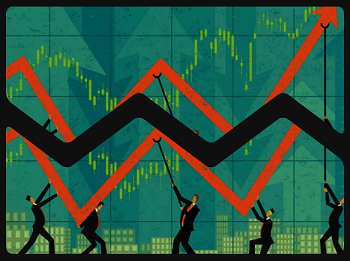
Everyone’s talking about Michael Lewis’ latest book Flash Boys: A Wall Street Revolt and HFT (high-frequency trading) and whether the markets are rigged.
What they’re not talking about is how the markets have been set up for institutionalized rigging.
I’m not kidding.
The markets are rigged. You’re going to have to get over it and deal with it.
The rigging is in the system and that’s just the way it is…
As to HFT, I’ll get to that…
But you can’t pass judgment on HFT until you understand how cascading technology and unintended consequences landed us in the deep end of the dark pool we now call the market….
And who really set the perfect table for the problem…
First, the Market Got Cloudier
To understand how the market works, which is really easy, you have to understand this:
In the old days the New York Stock Exchange (NYSE) was the stock market.
Buyers and sellers of listed shares used brokers to send orders to the NYSE Floor for execution. And, in the old days, stocks were traded in eighths of a dollar (that came from the old Spanish “pieces of eight” system that cut up silver coins into eighths).
So XYZ stock might trade at $25.00, or $25.125, or $25.25, or $25.375, or $25.50, and so on. You couldn’t trade a stock at $25.01, or anything other than in eighths of a dollar.
On the Floor, “specialists” are in charge of every stock. Their job was, and still is, to match up buyers and sellers and “keep a fair and orderly market” as they facilitate “price discovery.”
The specialist keeps a “book.” It used to be a big leather book; now it’s an electronic book. In the book the specialist keeps all the orders he’s gotten to buy shares and sell shares in whatever quantity and at whatever price customers are trying to complete transactions.
The specialist used to see all orders for the stocks they were in charge of because all orders had to come to them.
Besides matching up buyers and sellers, specialists can also trade for their own account. That means they can try and make money trading the stocks where they are specialists.
Here’s how the specialist makes real money, besides getting paid a tiny fee for matching up orders.
There used to be hundreds of orders in a specialist’s book. He knew for example that there was an order to buy 10,000 shares of XYZ at $25, and he saw all the buy orders lined up behind the current buy order. He also sees how many shares are being offered at all the prices customers want to sell stock at.
If the lowest priced order in his book to sell shares was for 5,000 shares at $25.25, and there was an order to buy 10,000 shares at $25, the specialist would “quote” the stock as “$25 by $25.25, 10,000 by 5,000.”
Everyone on the Floor near the specialist could hear him call out the quote, and clerks and brokers transmitting information back to their offices knew the quote. They all knew someone, or maybe a few aggregated orders, were trying to buy 10,000 shares and were willing to pay $25.
And that there was a seller, or a few sellers, trying to sell 5,000 shares at $25.25. If neither side budges, there is no trade. The quote can change if a buyer steps up and bids $25.125, or if a seller steps down and offers stock at that price. But if a buyer and seller don’t meet at the same price, there is no trade.
Enter again the specialist. He has the book. He might see that there are a lot more buy orders coming in. To make money, because he sees “order flow” is coming into the bid side, he would probably raise the bid himself and try and buy stock at $25.125, ahead of everyone else. If a seller comes down, or a new seller comes in and sells him stock at $25.125, let’s say he buys 5,000 shares, he would own 5,000 shares at $25.125.

